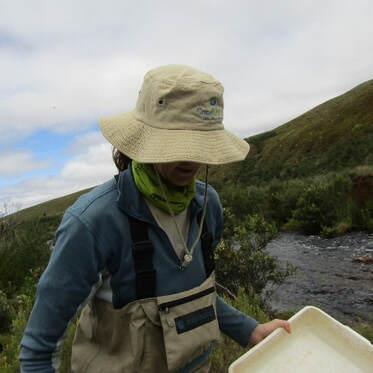|
Jeanne Gouws is a freshwater ecologist working for Cape Nature, based in the Western Cape. She regularly visits the Grootvadersbosch cConservancy to do freshwater monitoring in multiple river sites. She captures macro invertebrates to determine the health and other aspects of the river systems. I asked Jeanne what her favorite tree is, and she said without hesitation: “The fever tree is beautiful, and it is my favorite.” The tree is not found naturally in the Grootvadersbosch Conservancy or in the Western Cape but is a renowned feature in the lowveld of South Africa (Plant ZA). The fever tree occurs in spaces where underground water is present, or surface water accumulates, after summer rains (Plant ZA), also in low-lying swampy areas, along rivers. This sounds just like where our freshwater ecologist spends most of her time! The tree can be found from Kenya in the north to KwaZulu-Natal in the South. It is a very beautiful South African tree and, although it is not found here, because it is “Jeanne’s tree”, we are highlighting it anyway. The fever tree or Koorsboom (Vachellia xanthophloea) is a striking tree. The most interesting trait of the tree is the lime green to greenish-yellow, smooth bark. It is coated with a yellow-green, powdery substance which comes away when you rub it with your finger. The flowers are bright yellow and have a sweet scent (Plant ZA). The pods are flat with thin valves, yellowish brown to brown, slightly constricted between the seeds, hairless and somewhat straight (Van Wyk and van Wyk.,2013). The fever tree has lengthy straight white thorns which are gathered in pairs. The thorns differ from young trees to older ones. The thorns aid as a defense mechanism against herbivore predation (Milewski., et. al 1991). The name has an interesting origin. Early settlers thought that this tree caused fevers since people traveling or living in the areas where it grew contracted fevers. However, the fever tree grows in swampy areas that is ideal breeding ground for mosquitoes. Mosquitoes carried malaria so it was this myth that linked this tree to fever and hence the name “fever tree”. The tree provides food and protection for many animals. Birds like to build their nest in the tree because the thorns give them extra protection against predators. Elephants munch on the branches, giraffes and monkeys eat the pods, grey louries eat the flowers, baboons eat the gum and green seeds of the tree. Bees are also drawn to the yellow-colored flowers and the sweet scent. The tree provides a home for ants that are housed in the swollen thorns of the fever tree (Isbell., et. al 2013). The tree has multiple uses for humans too. The wood is hard and suitable for Timber. The bark of the tree is used as raw material in traditional medicine (Kotina et al, 2016). The bark is used for fever and eye problems (Plant ZA). The tree provides lovely shade for humans and other plants growing beneath or around it. A lovely garden tree. Finally, this plant plays a vital role in the nitrogen enrichment of soils, and this has a positive impact on the growth of other plants growing near it. The reason for this is because the tree has root nodules that contain nitrogen fixing bacteria. This is a very interesting tree indeed and we can see why Jeanne loves this tree. Truly special! Stay tuned for our next tree! References
http://pza.sanbi.org/vachellia-xanthophloea Isbell, L.A., Rothman, J.M., Young, P.J. and Rudolph, K., 2013. Nutritional benefits of Crematogaster mimosae ants and Acacia drepanolobium gum for patas monkeys and vervets in Laikipia, Kenya. American Journal of Physical Anthropology, 150(2), pp.286-300. Kotina, E.L., Tilney, P.M., and van Wyk, B.E., 2016. Identification of South African medicinal barks. Planta Medica, 82(S 01), p.P222. Milewski, A.V., Young, T.P. and Madden, D., 1991. Thorns as induced defenses: experimental evidence. Oecologia, 86(1), pp.70-75. Van Wyk, B., 2013. Field guide to trees of southern Africa. Penguin Random House South Africa.
0 Comments
Your comment will be posted after it is approved.
Leave a Reply. |
AuthorGVB Conservancy Staff Archives
May 2024
Categories |


 RSS Feed
RSS Feed






